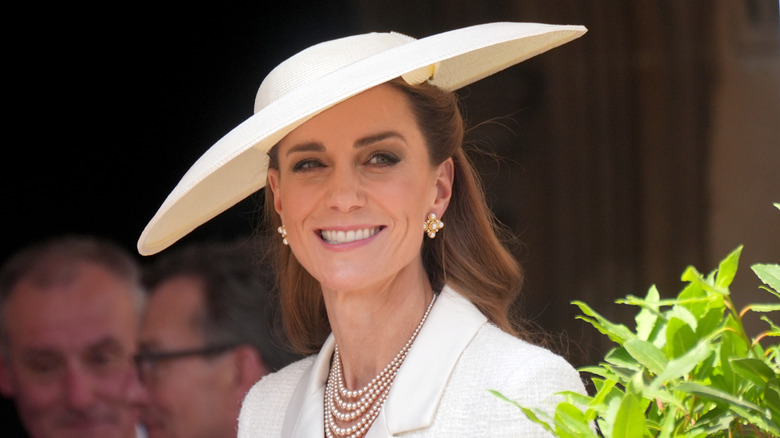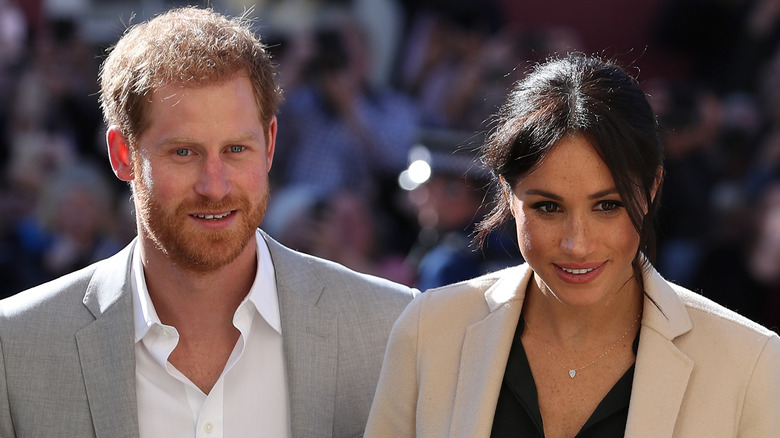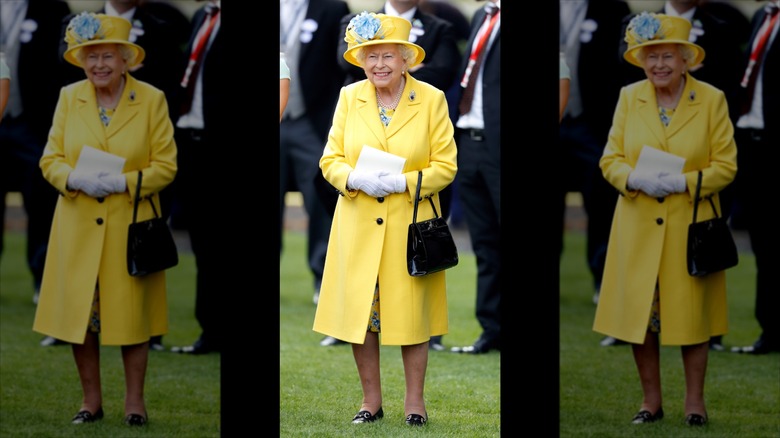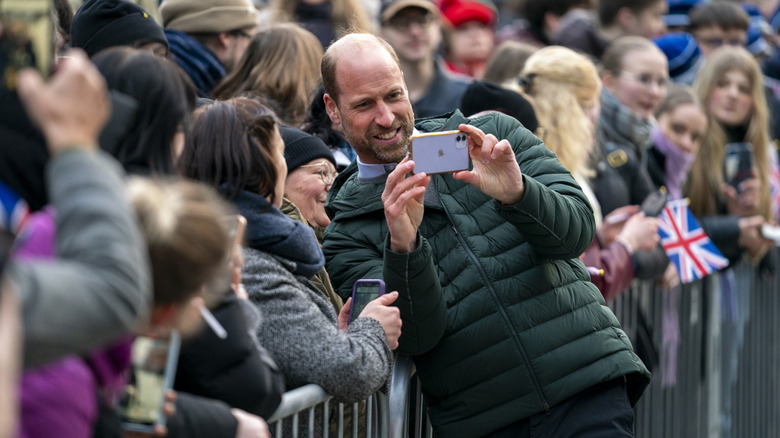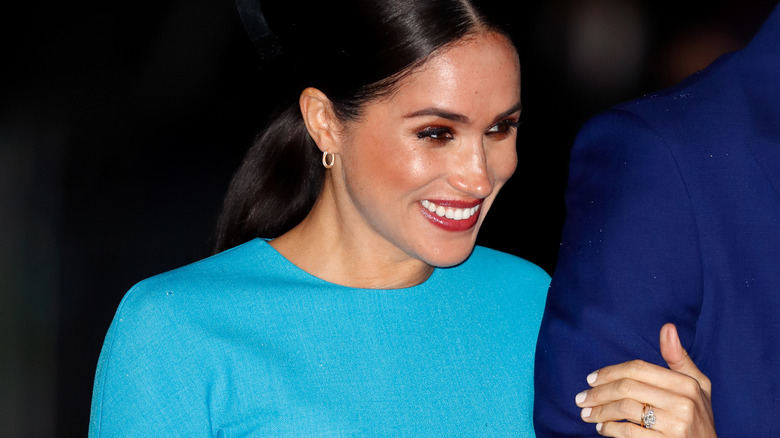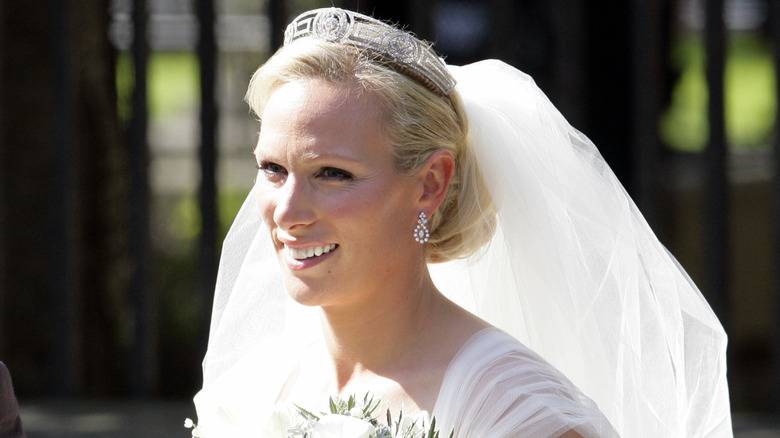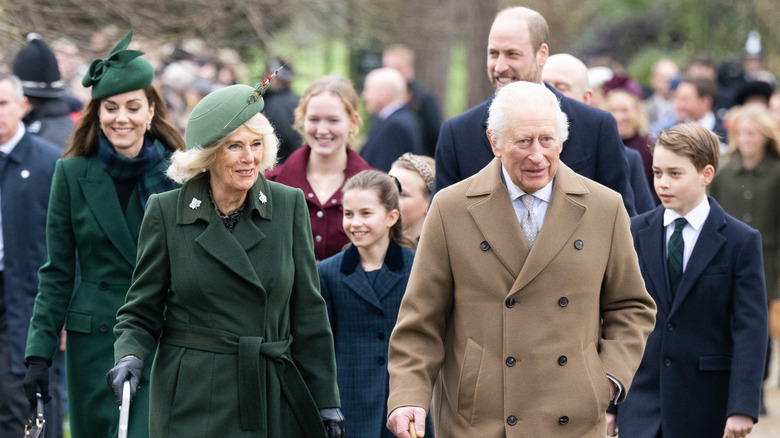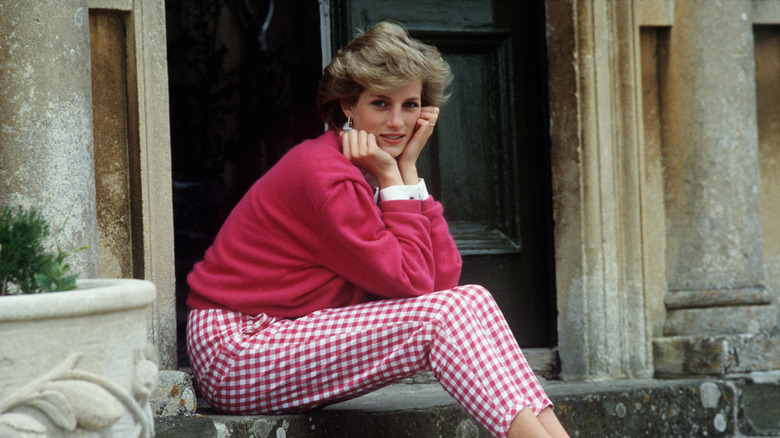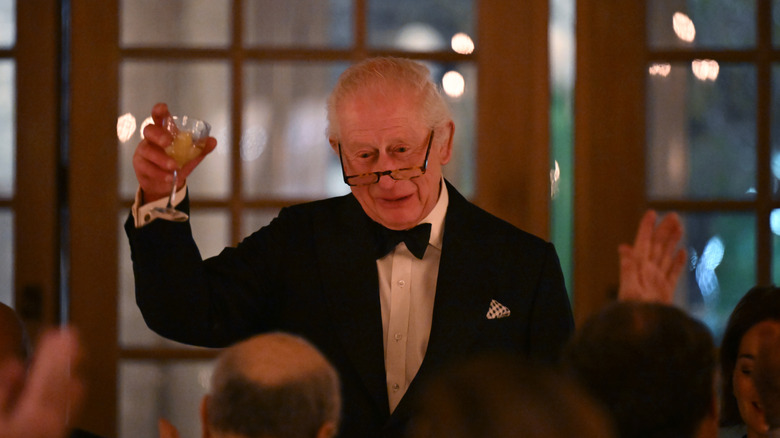Royal Rules & Protocols That Are Way Outdated
Being a royal isn't actually all it's cracked up to be. Despite being one of the most powerful people in the world for most of her life, there were still plenty of things that Queen Elizabeth was never allowed to do. And it's not just the monarch — everyone in the British royal family, and those who join them for events, have to follow bizarre protocols. There are rules royals have to follow when drinking alcohol, there are strange rules that guests must follow when dining with the royals, and there are even weird rules that royals have to follow in the bathroom.
It's understandable, though — they are worldwide figures who need to maintain a sense of decorum when in public. But decorum is subjective, and in modern times, many of these regulations just don't make any sense. Here are some royal rules and protocols that are way outdated.
The royals should be able to get engaged without the monarch's permission
A royal wants to get engaged? Great. All they have to do is follow strict protocol, including gaining permission from the monarch, before making or accepting a marriage proposal. And the protocol isn't some rule that Queen Elizabeth or her father implemented during their reign — there's an actual law called The Royal Marriages Act 1772 that states royals need the reigning monarch's approval before getting married. If someone gets married without the monarch's express permission, the marriage is considered invalid.
Luckily for the royals, the law seems like more of a formality than anything else. According to reports, there haven't been any serious concerns in recent times regarding legitimate contenders for new members of the royal family. Still, the law is incredibly archaic, removing a couple's autonomy to move their relationship forward as they see fit. Nevertheless, it is the law, and therefore the royals follow it. The most recent royal engagement came in 2018 between Prince Harry and Meghan Markle, and Queen Elizabeth, the reigning monarch at the time, issued her permission publicly. "We have consented and do by these Presents signify Our Consent to the contracting of Matrimony between Our Most Dearly Beloved Grandson Prince Henry Charles Albert David of Wales, K.C.V.O., and Rachel Meghan Markle," the queen stated. She issued a similar statement of permission in 2011 when Prince William and Princess Catherine got engaged.
Let the women go in public without hosiery
The royals are particular when it comes to appearance. They have to travel with black outfits in case someone dies, they can't wear black if they're not in mourning, jeans are only allowed in certain instances. Even the royal kids are subject to rules about what they can and can't wear before and beyond certain ages. Certain rules are reasonable — for instance, miniskirts are not allowed — but others are not necessary. Chief among them, women aren't supposed to be seen wearing a skirt or a dress without also wearing hosiery.
Anyone who's ever worn hosiery before knows why it's such a nuisance. It's not comfortable, and it almost always changes the color of the wearer's skin. While black hosiery is used as a fashion statement, nude hosiery is typically only used as an accessory for meeting traditional modesty standards. Women wearing hosiery was reportedly one of Queen Elizabeth's most important rules. As royal expert Kelly Lynch told Yahoo! Life of the rule, "The simple reason is, Her Majesty considers it ladylike, proper, and appropriate, and it's the one rule she won't budge on, regardless of temperature." But the hosiery rule has got to go. It's only feigning modesty — the wearer's legs are still visible to the public, and the royals wear long enough hemlines to prevent any wardrobe malfunctions. If a royal woman wants to wear hosiery, she should. But if she doesn't want to, she shouldn't have to.
There's no reason for the no selfies rule anymore
Technology has changed the way everyone in the world interacts with each other, and that includes the royal family. While many of their rules have been enacted for decades — some centuries — others are more recent, like Queen Elizabeth's rule, which has been upheld by King Charles, that members of the royal family aren't allowed to take selfies with fans. But technology becomes obsolete fast, and so has that rule. But how did it start? As a royal fan Greg Agnew, who attended a garden party at Buckingham Palace in 2017, told Insider, "The one thing they talked about a lot was no selfies, and the reason was that they didn't want people turning their backs to the Royal Family and the Queen. And that was very important to them. You do not turn your back on the Royal Family, and you do not attempt to walk up and talk to them."
Being respectful will never go out of style, but in this instance, the royal family is taking things a little too far, putting themselves on even more of a pedestal and making themselves less relatable. One royal is a little more lenient with selfies than the others — Prince William (Prince William has actually been caught breaking multiple royal rules). He is willing to take selfies with fans on occasion, and he and two of his children have taken a selfie with Taylor Swift and Travis Kelce.
Why are there so many antiquated ideas about nail polish?
According to some reports, royals are only allowed to wear neutral shades of nail polish, a protocol that came into question when Meghan Markle was seen wearing dark nail polish while serving as a senior member of the royal family. According to royal correspondent Omid Scobie, however, that protocol is misunderstood. "There's no actual protocol about dark nail polish," he told Harper's Bazaar. "It's simply about being appropriate — we'd never see [a royal wearing dark nail polish] at a royal engagement," he clarified, referring to Meghan wearing dark nail polish at the British Fashion Awards.
Even with that clarification, the rule seems to stand that dark nail polish isn't allowed at certain events. In fact, according to etiquette expert William Hanson, the protocol is even more specific. "[Nail polish] needs to be skin coloured so hot red and bright pink, for example, are not correct, especially for official occasions and particularly during mourning," Hanson told The Sun. These unofficial rules around nail polish seem to stem from Queen Elizabeth, who reportedly only wore a neutral pink shade herself. But what is the purpose of these rules, especially now? Nail polish is a form of self expression, and the royals shouldn't be beholden to one woman's idea of what's appropriate and what's not. Rules around nail designs would be understandable — no one should sport anything that's offensive. But any solid nail color should be acceptable on a royal's hands.
Women should have more freedom when sitting
The royals have rules about everything, including sitting. According to etiquette expert Myka Meier, one of the most classic ways to sit like a royal is dubbed the "Cambridge Cross." "The Cambridge Cross is one of the Duchess of Cambridge's favorite sitting positions because it's comfortable, looks really elegant, and very easy to do," Meier told People. The position involves keeping the knees together, crossing the ankles, keeping the feet flat on the ground, and sitting upright without the back or the arms using any supports. Anyone who's seen Princess Catherine sitting in public has almost certainly seen her sitting in this position.
While the "Cambridge Cross" does look elegant, and it and other royal sitting positions do prevent the Windsors from suffering any wardrobe malfunctions, certain aspects of royal sitting positions are arbitrary and unnecessary. There are plenty of ways to sit at a function that retain modesty and posture, two things the royals are very concerned about, without sacrificing comfort (there's no way anyone is totally comfortable sitting with their back away from a backrest for an extended period of time). Protocols that are masked in appropriateness are often ways to stifle freedom and individuality, and the royal sitting rules do just that. The royals, women especially, should have more sitting options that balance appropriateness with freedom.
Unmarried women should be able to wear tiaras, too
Tiaras are fabulous and expensive pieces of jewelry associated with royalty. They're so special, though, that not even royals get to wear the baubles whenever they want. While it's understandable to reserve such significant pieces of jewelry for certain occasions, some of the rules are quite outdated. For example, in the royal family, most women are not allowed to wear tiaras until their wedding day. As tiara expert Geoffrey Munn told Town & Country, "Ancient tradition has it that they must be a bride or already married. The tiara has its roots in classical antiquity and was seen as an emblem of the loss of innocence to the crowning of love."
But what if a woman in the royal family chooses not to get married? What if she marries someone who the monarch disapproves of and her marriage is considered invalid? The rule is understandable as it relates to members of the royal family who became royal by marriage, like Princess Catherine and Meghan Markle, but it's outdated for the women born into royalty, like Princess Beatrice, Princess Eugenie, and Zara Tindall. Someone might be able to flout the rule with permission, though — Princess Charlotte. The young royal has already sported certain headpieces on special occasions, like King Charles' coronation, leading experts to believe that she may be allowed to wear a tiara before she is married, as Princess Anne and Princess Margaret did sparingly before their marriages.
Stop weighing people on Christmas
For a family that is so concerned with etiquette, the Windsors have one tradition that is particularly cavalier. According to reports, each guest at Christmas weighs themselves before and after their visit to Sandringham (and that's not the only weird royal family holiday tradition). The idea is that all the guests are supposed to gain a few pounds while at Sandringham, as it shows that everyone had plenty to eat over the holidays.
While the idea is seemingly presented in good fun, it's also quite insensitive. Not everyone is comfortable sharing their weight, and this tradition forces everyone to do just that. Guests may be actively gaining or losing weight — perhaps for health, pregnancy, or their appearance — and may not want to talk about their weight. Guests may also be gaining or losing weight against their wishes and may not want a reminder. The tradition is particularly insensitive to anyone with an eating disorder, and it still being in royal practice is even more confounding considering Princess Diana very openly lived with an eating disorder much of her adult life. The political optics of the tradition aren't great, either. While many people across the British Commonwealth are so food insecure that they can't eat anything on Christmas Day, let alone a special meal, the monarch and company have access to so much food that it could have a noticeable impact on their weight. It's time for the weigh-ins to cease.
Are the hat rules really necessary?
Ever wondered why royals never wear hats in the evening? Or why royals wear hats at all? Well, like most royal rules, the guidelines around when a royal can and can't wear a hat are steeped in antiquity, and they only apply to women. One such royal rule is that women can't wear hats after six in the evening. As Grant Harrold, former personal butler to King Charles, told Hello!, "There was a rule that stated ladies could wear hats from the morning at 6 am until 6 pm. After this, they would wear tiaras if they were married. If they didn't wear tiaras, this would mean they were single and looking to mingle. Royal women follow this old etiquette rule." Royal protocol around courtship has changed, and so should the rules around hats. Women have voices — they don't need hats to serve as a signal regarding their relationship status.
There are loads of other stipulations with headpieces, and they're equally ridiculous. There are certain occasions where fascinators are allowed, and others where they're not allowed. And royals can't just wear any old hat they find online — only certain designers are allowed to adorn the Windsor women's heads. Many of the traditions surrounding hats have to do with a display of wealth, which is elitist, but also unnecessary. No one is questioning whether the royals are wealthy. Let them wear what they want.
If royals are tired, they should be able to go to bed
From the outside, it seems that members of the royal family will bend over backward to show respect to the monarch. While it's good to show respect, it shouldn't be expected at the expense of a person's own wellbeing. For example, one royal rule is that no one is allowed to go to bed before the monarch, and this doesn't just apply to the royals themselves. "Guests cannot go to bed before the Queen, who reportedly tucks in at midnight," etiquette coach Zarife Hardy told Harper's Bazaar, per Express.
Not everyone in the royal family has been so fond of this rule. As Sir William Heseltine, former private secretary to Queen Elizabeth, shared in the book "The Royals in Australia," Princess Diana was particularly miffed by the rule. "For Diana the long royal evenings were agony. There'd be an hour or so in the sitting room of everyone sitting around making conversation. And Diana was driven to such extremes that she'd excuse herself and go to bed, which was thought to be rather bad form, going to bed before the Queen," he said. Now, monarchs are important figures in their countries, and they should be treated with respect, but going to bed isn't disrespectful. If this protocol hasn't changed with King Charles, it needs to in the future.
Monarchs shouldn't dictate something as basic as eating
Sleep isn't the only basic human need arbitrarily dictated by the monarch. Eating is, too. While these rules only apply while eating with the actual king or queen, they're still absurd. For example, the monarch decides when meals start and end. As etiquette expert William Hanson told Marie Claire, "When dining with Her Majesty, no one should begin until the Queen begins eating; similarly, when The Queen's cutlery goes into the finished position ... everyone else should follow suit — regardless of whether there is food left on their own plates." That's right — no eating before or after the monarch. Anyone eating with the monarch can finish their meal before the monarch has finished theirs, though there is a protocol that must be followed to signal that a guest is done.
Some royal food rules, though, are easy to get behind, like the no garlic rule. Queen Elizabeth did not allow garlic to be served at royal functions, and if she's paying for the meal, she can serve what she wants. And who wants to smell garlic on another person's breath at a white tie affair? Elizabeth was on to something with that rule.
If you need help with an eating disorder, or know someone who does, help is available. Visit the National Eating Disorders Association website or contact NEDA's Live Helpline at 1-800-931-2237. You can also receive 24/7 Crisis Support via text (send NEDA to 741-741).
